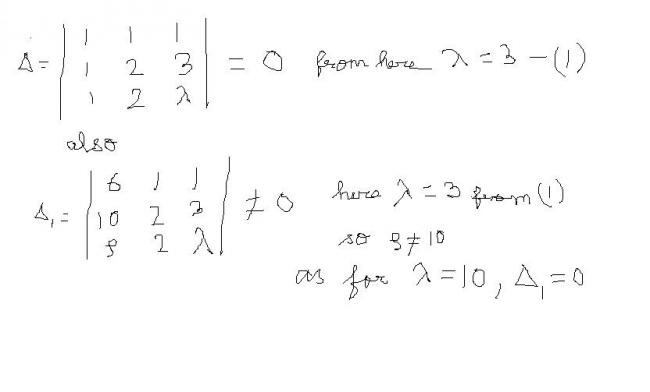1.
evaluating the determinant we get
(1- x)^2 as the value
so degree is 2
option a)
1.
evaluating the determinant we get
(1- x)^2 as the value
so degree is 2
option a)
What is the problem with 3?
That seems to be the simplest..
Have you tried it..
Show some of your approach..
I haven't encountered questions which says "expressed as linear polynomial''....what does it mean?
finding A3.. A2 also doesn't seem to help.
\begin{bmatrix} 1 & 4\\ 2 &3 \end{bmatrix}
now finding characteristic equation by cayley hamilton
we get equation as
A^2 - 4A - 5I = 0 ---- 1
from d given equation we have
A^5 - 4A^4 - 7A^3 + 11A^2 - A - 10 I
which can be written as
A^5 - 4A^4 - 5A^3- 2A^3 + 11A^2 - A - 10 I
now combining first three terms
(A^5 - 4A^4 - 5A^3 )- 2A^3 + 11A^2 - A - 10 I
A^3(A^2 - 4A - 5I )- 2A^3 + 11A^2 - A - 10 I
BUT THE EXPRESSION IN bracket is 0 ( from ---1 )
equation reduces to
A^3(0 )- 2A^3 + 11A^2 - A - 10 I
this equation can be written as
- 2A^3 + 8A^2 + 3A^2+ 10A - 10 I - ( 11 A)
REARRANGING
( - 2A^3 + 8A^2 + 10A)+ 3A^2 - 10 I - ( 11 A)
THIS EQUATION REDUCES too
- 2A( A^2 -4A -5I)+ 3A^2 - 10 I - ( 11 A)
again expression in bracket is 0 ( from ---1 )
equation reduces too
3A^2 - 10 I - ( 11 A)
which can be written as
3A^2 - 12A -15 I + ( A + 5I)
3 [ A^2 - 4A -5 I ] + ( A + 5I)
EXPRESSIon is square bracket is 0
hence ans is
option a)
Q1.
[ C1 → C1 + C2 + C3 ]
\begin{vmatrix} 1+a^{2}x+x+b^{2}x+x+c^{2}x & (1+b^{2})x & (1+c^{2})x\\ x+a^{2}x+1+b^{2}x+x+c^{2}x& 1+b^{2}x &(1+c^{2}) x\\ x+a^{2}x+x+b^{2}x+1+c^{2}x&(1+b^{2})x & 1+c^{2}x \end{vmatrix}
\begin{vmatrix} 1+2x+(a^{2}+b^{2}+c^{2})x & (1+b^{2})x & (1+c^{2})x\\ 1+2x+(a^{2}+b^{2}+c^{2})x& 1+b^{2}x &(1+c^{2}) x\\ 1+2x+(a^{2}+b^{2}+c^{2})x&(1+b^{2})x & 1+c^{2}x \end{vmatrix}
=\begin{vmatrix} 1 & (1+b^{2})x & (1+c^{2})x\\ 1& 1+b^{2}x &(1+c^{2}) x\\ 1&(1+b^{2})x & 1+c^{2}x \end{vmatrix}
=\begin{vmatrix} 1 & (1+b^{2})x & (1+c^{2})x\\ 0& 1+b^{2}x-x-b^{2}x &(1+c^{2}) x-x-c^{2}x\\ 0&(1+b^{2})x-x-b^{2}x & 1+c^{2}x-x-c^{2}x \end{vmatrix}
=\begin{vmatrix} 1 & (1+b^{2})x & (1+c^{2})x\\ 0& 1-x &0\\ 0&0 & 1-x \end{vmatrix}
=\begin{vmatrix} 1-x &0 \\ 0& 1-x \end{vmatrix}
= ( 1 - x )2
= x2 + 1 - 2x
hence degree is 2
for 2,use cramers rule.
for the equations to have no solution,
Δ=0(where Δ is the determinant of the cofficients of x,y,z)
Δ1≠0(if all of them are 0 there will be infinite solutions)